Aquant, has recently published the 2022 Service Intelligence Benchmark Report, now available at Field Service News, which offers an in-depth analysis of field service performance and customer satisfaction in a year of talent shortage, COVID service...
ARCHIVE FOR THE ‘customer-experience’ CATEGORY
Nov 18, 2021 • Features • Digital Transformation • Aquant • Covid-19 • customer experience
Aquant, has recently published the 2022 Service Intelligence Benchmark Report, now available at Field Service News, which offers an in-depth analysis of field service performance and customer satisfaction in a year of talent shortage, COVID service pivots, and shifting customer demands. In this excerpt from the report, we look at what KPIs do and don't tell us.
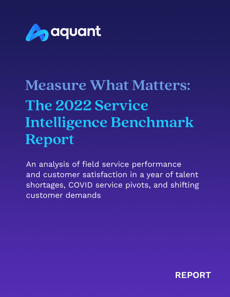
This feature is just one short excerpt from a report published by Aquant
www.fieldservicenews.com subscribers can read the full report now by hitting the button below.
If you are yet to subscribe you can do so for free by hitting the button and registering for our complimentary subscription tier FSN Standard on a dedicated page that provides you instant access to this white paper PLUS you will also be able to access our monthly selection of premium resources as soo as you are registered.
 Data usage note: By accessing this content you consent to the contact details submitted when you registered as a subscriber to fieldservicenews.com to be shared with the listed sponsor of this premium content Aquant who may contact you for legitimate business reasons to discuss the content of this white paper, as per the terms and conditions of your subscription agreement which you opted into in line with GDPR regulations and is an ongoing condition of subscription.
Data usage note: By accessing this content you consent to the contact details submitted when you registered as a subscriber to fieldservicenews.com to be shared with the listed sponsor of this premium content Aquant who may contact you for legitimate business reasons to discuss the content of this white paper, as per the terms and conditions of your subscription agreement which you opted into in line with GDPR regulations and is an ongoing condition of subscription.
WHAT KPI MEASUREMENTS DO AND DON'T TELL US
KPIs don't equal customer sentiment
In the Service Leader’s Guide to Workforce KPIs, we examined why workforce measurement is more critical than ever, and we defined best practices for measurement criteria.
For the 2022 Service Intelligence Benchmark Report, we went a step further. We analyzed service data to understand service performance beyond KPI measurement. We found that knowing your KPIs—by number or average performance—is not the same as understanding what those numbers reveal about customer satisfaction, employee skill level, or overall service performance. Averages don’t disclose the specific details you need to make critical service decisions.
Service KPIs by the numbers
Here’s the breakdown of how service organizations measure up against other organizations and the industry as a whole.
FTFR - First Time Fix Rate
What is it?
First Time Fix rate is one of the most popular metrics for workforce measurement. It indicates how often someone is able to fix an issue on the first try. In this report, we are measuring the FTF rate of field visits, in a 30-day window.
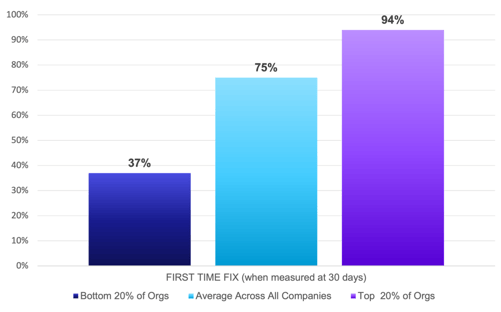
Key Observation:
FTF rates have hovered around 75% for more than a decade—and remained stagnant for all but a handful of top-performing companies. Additionally, FTF rates should never be measured in isolation. On average, a failed first visit leads to 2.5 additional visits and 20 days for MTTR.
CPS - Cost Per Success
What is it?
The total amount required to successfully close a service ticket is known as the Cost Per Success (CPS). This is a bit different from other similar-sounding KPIs, such as Cost Per Truck Roll, since total CPS may include multiple visits, multiple truck rolls, a variety of parts, and other labor costs.
Some organizations may measure Cost Per Work Order, but that metric leaves out cases that include always assigning experts to the most complex (and expensive) jobs. Additionally, it does not account for cases where multiple work orders are related to the same core issue.
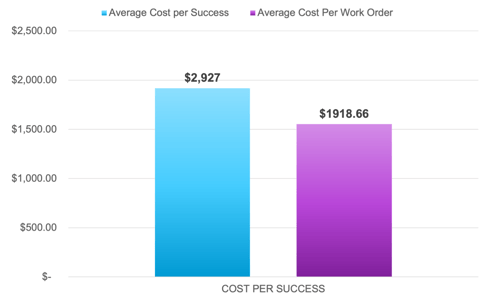
Key Observation:
Successfully resolving an issue involves nearly 42% more in costs versus looking at work orders individually. While average costs are dependent on the company and type of equipment being serviced, the cost difference is the most important to keep in mind.
MTTR - Mean Time to Resolution
What is it?
The Mean Time to Resolution KPI measures the time it takes to resolve a customer issue. Typically, it’s the time between the case creation date and the closure date. Similar to the pain of staying on hold when trying to resolve a personal issue, minimizing MTTR is a key factor in increasing positive customer experiences and reducing service costs. In the last year, we’ve seen a growing divide in this metric.
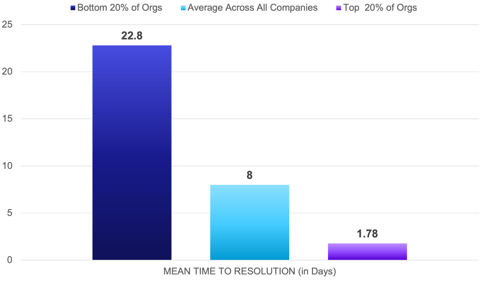
MTTR (in days):
• 8 days: average across all companies• 1.78 days: top 20% of organizations• 22.8 days: bottom 20% of organizations
MTBF - Mean Time Between Failures
What is it?
Mean Time Between Failures quantifies the average time between customer issues. Service organizations try to maximize this metric because a higher rate represents excellent service quality and maximum uptime.
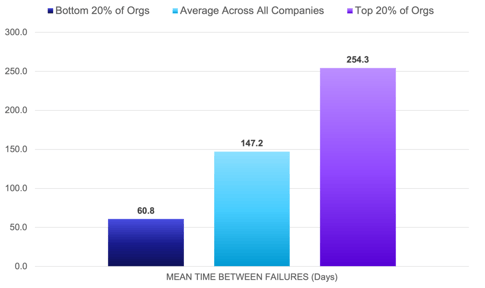
• 139.9 days: Average across all companies (147.2 in 2021)
• 231.8 days: Top 20% of organizations (254.3 in 2021)
• 57.5 days: Bottom 20% of organizations (60.8 in 2021)
Key Observation:
Individual pieces of equipment may have differing life cycles, but service leaders need to understand underlying patterns—in both their machines and workforces. When visiting a job site, experienced service heroes know how to use their time wisely and ensure that assets are working properly before leaving. This can significantly extend the time between failures.
MTBV - Mean Time Between Visits
What is it?
Need to calculate both uptime and service performance? Look no further than the Mean Time Between Visits metric. This measures every visit you have for an asset or customer, instead of only tracking time between failures.
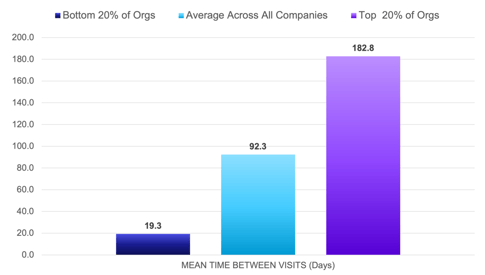
• 92.3 days: average across all companies
• 182.8 days: top 20% of organizations
<• 19.28 days: bottom 20% of organizations
Key Observation:
Experienced techs will skew towards longer time intervals between visits. That’s great news, thanks to low repeat visit rates, as well as their ability to utilize every visit to maximize uptime.

This feature is just one short excerpt from a report published by Aquant.
www.fieldservicenews.com subscribers can read the full report now by hitting the button below.
If you are yet to subscribe you can do so for free by hitting the button and registering for our complimentary subscription tier FSN Standard on a dedicated page that provides you instant access to this white paper PLUS you will also be able to access our monthly selection of premium resources as soo as you are registered.
 Data usage note: By accessing this content you consent to the contact details submitted when you registered as a subscriber to fieldservicenews.com to be shared with the listed sponsor of this premium content Aquant who may contact you for legitimate business reasons to discuss the content of this white paper, as per the terms and conditions of your subscription agreement which you opted into in line with GDPR regulations and is an ongoing condition of subscription.
Data usage note: By accessing this content you consent to the contact details submitted when you registered as a subscriber to fieldservicenews.com to be shared with the listed sponsor of this premium content Aquant who may contact you for legitimate business reasons to discuss the content of this white paper, as per the terms and conditions of your subscription agreement which you opted into in line with GDPR regulations and is an ongoing condition of subscription.
Further Reading:
- Read more about Aquant on Field Service News @ www.fieldservicenews.com/aquant
- Read more about Digital Transformation @ www.fieldservicenews.com/digital-transformation
- Read more about Leadership & Strategy @ www.fieldservicenews.com//leadership-and-strategy
- Learn more about Aquant @ www.aquant.io
- Follow Aquant on Twitter @ twitter.com/Aquant_io
Nov 12, 2021 • Features • White Paper • FieldAware • Leadership and Strategy • customer experience • customer success
In the second feature from a recent white paper we published in partnership with FieldAware, we analyse the need of a shift in management structure for service organisations with a customer success focused model.
In the second feature from a recent white paper we published in partnership with FieldAware, we analyse the need of a shift in management structure for service organisations with a customer success focused model.

This feature is just one short excerpt from a recent white paper we published in partnership with FieldAware.
www.fieldservicenews.com subscribers can read the full white paper now by hitting the button below.
If you are yet to subscribe you can do so for free by hitting the button and registering for our complimentary subscription tier FSN Standard on a dedicated page that provides you instant access to this white paper PLUS you will also be able to access our monthly selection of premium resources as soo as you are registered.

Data usage note: By accessing this content you consent to the contact details submitted when you registered as a subscriber to fieldservicenews.com to be shared with the listed sponsor of this premium content FieldAware who may contact you for legitimate business reasons to discuss the content of this white paper, as per the terms and conditions of your subscription agreement which you opted into in line with GDPR regulations and is an ongoing condition of subscription.
Suppose we consider customer success more in line with a servitization model than simply increasing CSAT metrics. In that case, we may start to see a more straightforward path towards developing the model. However, this
also leads us to conclude that such a shift in focus for a service organization will require significant changes within processes and potentially a change in management structure.
The established servitization models are centred around establishing long- standing partnerships between the service provider and the customer. Indeed, as we look at many of the high-profile examples of servitization, often in the early adoption of such service strategies, not only is customer selection crucial, very often, the evolution of the service model is one of genuine co-creation.
One acknowledged approach in developing such forward looking service design is establishing a tiger team – a group of specialists dedicated to the project full- time. In the co-creation model, such a team can comprise both organizations bringing in their specialist expertise, knowledge and insight. Additionally,
both organizations also develop the new approach parallel to existing service agreements, which is especially important when considering the mission-critical status that field service operations hold.
However, once the proof of concept is established, should the service provider wish to roll out a more comprehensive servitized offering, a clear management structure to facilitate the effective rollout is required.
We would expect to see an executive-level leader at the top of this structure – ideally reporting directly to the CEO.
Such a position may come in several guises. One option is the role of a chief revenue officer (CRO), which we are beginning to see emerge as a blend of the two roles of Chief Service Officer and Chief Sales Officer.
Another alternative could be Vice President of Customer Success. For ease of reference, we shall use the term CRO in this paper. Regardless of the name, the function of the role remains the same.
This is a position that requires an intimate understanding of where the value proposition of the service provider lies within the eyes of the customer (to drive successful approaches to revenue generation), while simultaneously having detailed knowledge of how the service operations can effectively meet the service delivery requirements while retaining efficiency both in terms of internal costs but also meeting the customer goals.
In addition to both of these skillsets, the potential CRO must also have the broader business acumen and insight to see how such a move will impact and draw upon other aspects of the organization as well – from R&D through to marketing.
Beneath the CRO, a hypothetical management structure could be mapped out into three key areas as per the graphic below.
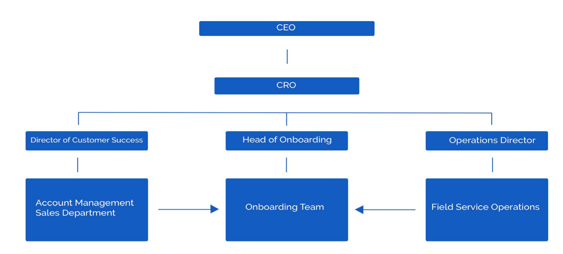
On the left-hand side, we have a customer success team led by a director of customer success.
This would be a business division that evolves from the traditional sales team – with a heavier emphasis from account management on customer success and account development – i.e. building those long-standing, more deeply embedded relationships discussed earlier.
On the right-hand side, this structure is where our service operations business unit sits under the leadership of an operations director.
On this side of the operation, the shift in focus is perhaps less pronounced than the sales operation. In one sense, little changes in seeking the maximum efficiency and operational metrics such as technician utilization, mean-time-to- repair and first-time-fix rates remain as crucial as ever.
Ultimately, even in a fully servitized business model, the SLAs to be adhered to remain the same; however, they move from being an external agreement with the customer to being an internal requirement designed to allow the service operation to meet the guarantees of uptime that are now the bedrock of service contract.
However, we see a potential new business unit emerge in the centre of this new management structure – one dedicated to onboarding. In this case, it is also important to note that onboarding isn’t limited to new customers.
" While a similar structure could be adopted for various types of servitized offering, be it outcome-based service or a customer success focused model, the evolutionary leap from a csat focus will very likely involve both executive- level support and some restructuring of management structure..."
Most service organizations adopting such an approach will be taking their existing customers from a service model that they have been comfortable with for a long time to a far more holistic and encompassing model of service delivery.
Such significant change will almost always face some form of resistance. It is essential to have this interim team in place to help guide the customers through the transition from what is often a transactional relationship initially to one that becomes a true partnership.
Ideally, this onboarding team will bring a blend of in-depth operational experience and fantastic account management skills. A recommended approach could be to draw from both the operations and sales sides of the business to establish this new business unit.
This is, of course, just one hypothetical and fairly straightforward management structure to help illustrate the point. Many more complex variations could be implemented to achieve the effective development of a servitized or customer success-focused business model.
What is clear, though, is that while a similar structure could be adopted for various types of servitized offering, be it outcome-based service or a customer success focused model, the evolutionary leap from a CSAT focus will very likely involve both executive-level support and some restructuring of management structure.
Another critical aspect essential to the successful adoption of such a model is the easy flow of data across business units and the proper technological infrastructure to ensure that the service operation can operate at maximum efficiency – which we will discuss in the next feature from this white paper.

This feature is just one short excerpt from a recent white paper we published in partnership with FieldAware..
www.fieldservicenews.com subscribers can read the full white paper now by hitting the button below.
If you are yet to subscribe you can do so for free by hitting the button and registering for our complimentary subscription tier FSN Standard on a dedicated page that provides you instant access to this white paper PLUS you will also be able to access our monthly selection of premium resources as soo as you are registered.
 Data usage note: By accessing this content you consent to the contact details submitted when you registered as a subscriber to fieldservicenews.com to be shared with the listed sponsor of this premium content FieldAware who may contact you for legitimate business reasons to discuss the content of this white paper, as per the terms and conditions of your subscription agreement which you opted into in line with GDPR regulations and is an ongoing condition of subscription.
Data usage note: By accessing this content you consent to the contact details submitted when you registered as a subscriber to fieldservicenews.com to be shared with the listed sponsor of this premium content FieldAware who may contact you for legitimate business reasons to discuss the content of this white paper, as per the terms and conditions of your subscription agreement which you opted into in line with GDPR regulations and is an ongoing condition of subscription.
Further Reading:
- Read more about Digital Transformation @ www.fieldservicenews.com/digital-transformation
- Read more about Data Management @ www.fieldservicenews.com/data-management
- Read more about FieldAware on Field Service News @ www.fieldservicenews.com/exel
- Learn more about FieldAware @ www.fieldaware.com
- Follow FieldAware on Twitter @ twitter.com/fieldaware
Nov 11, 2021 • Features • Digital Transformation • Aquant • Covid-19 • customer experience
Aquant, has recently published the 2022 Service Intelligence Benchmark Report, now available at Field Service News, which offers an in-depth analysis of field service performance and customer satisfaction in a year of talent shortage, COVID service...
Aquant, has recently published the 2022 Service Intelligence Benchmark Report, now available at Field Service News, which offers an in-depth analysis of field service performance and customer satisfaction in a year of talent shortage, COVID service pivots, and shifting customer demands.

This feature is just one short excerpt from a report published by Aquant
www.fieldservicenews.com subscribers can read the full report now by hitting the button below.
If you are yet to subscribe you can do so for free by hitting the button and registering for our complimentary subscription tier FSN Standard on a dedicated page that provides you instant access to this white paper PLUS you will also be able to access our monthly selection of premium resources as soo as you are registered.
 Data usage note: By accessing this content you consent to the contact details submitted when you registered as a subscriber to fieldservicenews.com to be shared with the listed sponsor of this premium content Aquant who may contact you for legitimate business reasons to discuss the content of this white paper, as per the terms and conditions of your subscription agreement which you opted into in line with GDPR regulations and is an ongoing condition of subscription.
Data usage note: By accessing this content you consent to the contact details submitted when you registered as a subscriber to fieldservicenews.com to be shared with the listed sponsor of this premium content Aquant who may contact you for legitimate business reasons to discuss the content of this white paper, as per the terms and conditions of your subscription agreement which you opted into in line with GDPR regulations and is an ongoing condition of subscription.
In this comprehensive data report, Aquant analyzed how service organizations and their workforce measureD up against industry benchmarks.
We also explored service performance from a customer perspective. Aquant analyzed more than six million service tickets to reveal:
-
A snapshot of the overall industry and how companies measure up against each other
-
The reason why hitting your KPIs rarely equates to outstanding customer experiences
-
The spiraling impact of a missed First Time Fix (FTF) event
-
An increase in the workforce skills gap
-
COVID-19’s impact on service
We provide recommendations to:
-
Start making immediate business improvements by looking at service performance in a comprehensive way
-
Boost the customer experience in the short-term and long-term
-
Upskill a team in the face of a talent shortage
-
Succeed amid post-Covid service disruptions
KEY FINDINGS
KPIs Are Only as Meaningful As How You Measure Them
First Time Fix is a Distorted Barometer of Service Quality
Organizations that monitor KPIs in isolation may think they are hitting their numbers and providing great service. However, there’s a good chance that they are providing sub-par customer experiences.
Organizations that measure FTF rates at seven days or 14 days actually have much lower long-term success rates than their dashboards reveal. This is because fixes marked as complete on day one often require additional visits on day two through day 14 to fix a persistent problem that may have been incorrectly or inadequately addressed on the first visit. For example, if you wrap a leaking hose with duct tape to stop a leak, you’ve put a bandaid on a problem without fixing the root issue. The customer may call to reopen that ticket when they discover another leak in the following week.
-
86.6% is the FTF rates when measured in 7-day windows
-
81.5% is the FTF rates when measured in 14-day windows
-
75% is the FTF rates when measured in 30-day windows
The other argument against relying too heavily on FTF rates is that high values often mask other issues, such as:
-
Employees who shotgun parts to hit KPIs
- High labor costs due to labor to over-reliance on industry veterans
The way organizations provide service today is not in tune with customer expectations. Even with an average FTF rate, one in every four jobs requires at least one repeat visit.
Variations on FTF measurements are one reason for the disconnect. Other contributing factors include:
- Lack of insights into an organization’s core health
- A workforce labor shortage
- Inability to connect the dots between service performance and customer experience
- Reactive vs. proactive service
In 2021, service organizations faced even larger hiring challenges than in the past. This has left the industry with tens of thousands of unfilled jobs, and some reports estimate there will be an industry-wide shortage of three million skilled trade workers in the next five years.
-
The bottom quarter of the workforce costs organizations 84% more than the top quarter. That’s 4% higher than last year.
-
- The top 20% of the workforce (service heroes) has a 75% FTF rate. The bottom 20% of the workforce (service challengers) has a FTF rate of 59%.
Mean Time to Resolution (MTTR) increased during COVID, showing that jobs were completed faster. Part of that increase is attributed to more service organizations adopting remote resolution technology. This technology helps customers address minor issues themselves through self-service solutions. It also enables service organizations to diagnose—and even repair—issues without the need to send a tech on-site, thus reducing time and costs.
This is also a sign of resiliency across service organizations, many of whom were able to adapt in the face of ever-changing circumstances.
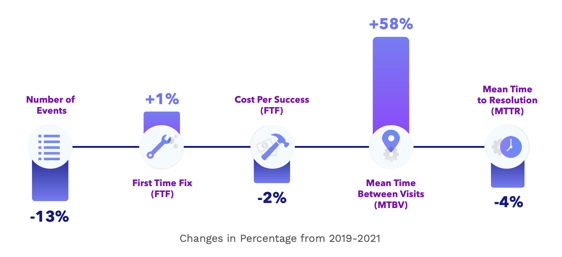
The insights in this report, gleaned from actual service data, provides a path to service improvements through a multi-step process.
-
Learn how to accurately identify your organization’s core service problems by better understanding the patterns in your service data
-
Use those data patterns to drive actionable service recommendations—for management-level decisions and in-the-field fixes
-
Plan proactive customer experience enhancements
-
Make more informed workforce training and hiring decisions to shrink the skills gap
How We Compiled the Data
Aquant gathered and analyzed actual anonymized service data from more than 76 leading service organizations. The data in this report was measured before an organization deployed Aquant’s AI solution.
The report measures:
- 76 organizations, including service divisions within OEMs and third- party service organizations across manufacturing, medical devices, capital equipment, HVAC, commercial appliances, and more
- More than 6 million work orders
- More than 31,000 technicians
- $7 billion total in service costs
- An average of 3 years of service data per company
 How We Define the Service Workforce
How We Define the Service Workforce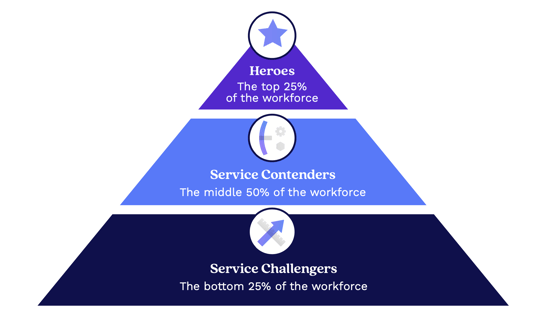 How is this Report Different from Standard Service Benchmarks?
How is this Report Different from Standard Service Benchmarks?• We analyzed real service data to understand the health and outlook of organizations instead of relying on service executives to self-report KPIs. Data sources included service tickets, CRM data, parts information, and more.
• We charted the skills gap. This makes it easy to extrapolate how much an organization can gain in efficiency and cost savings if the entire workforce was able to perform more like your experts.
• We analyzed the data using the Aquant Service Intelligence Platform, which includes a Natural Language Processing (NLP) engine built for the service industry. This lets us dig deep into data ranging from CRM and parts inventory to service tickets, handwritten records, and other information that never makes it into any databases. We are able to draw out patterns and recommendations based on raw data.

This feature is just one short excerpt from a report published by Aquant.
www.fieldservicenews.com subscribers can read the full report now by hitting the button below.
If you are yet to subscribe you can do so for free by hitting the button and registering for our complimentary subscription tier FSN Standard on a dedicated page that provides you instant access to this white paper PLUS you will also be able to access our monthly selection of premium resources as soo as you are registered.
 Data usage note: By accessing this content you consent to the contact details submitted when you registered as a subscriber to fieldservicenews.com to be shared with the listed sponsor of this premium content Aquant who may contact you for legitimate business reasons to discuss the content of this white paper, as per the terms and conditions of your subscription agreement which you opted into in line with GDPR regulations and is an ongoing condition of subscription.
Data usage note: By accessing this content you consent to the contact details submitted when you registered as a subscriber to fieldservicenews.com to be shared with the listed sponsor of this premium content Aquant who may contact you for legitimate business reasons to discuss the content of this white paper, as per the terms and conditions of your subscription agreement which you opted into in line with GDPR regulations and is an ongoing condition of subscription.
Further Reading:
- Read more about Aquant on Field Service News @ www.fieldservicenews.com/aquant
- Read more about Digital Transformation @ www.fieldservicenews.com/digital-transformation
- Read more about Leadership & Strategy @ www.fieldservicenews.com//leadership-and-strategy
- Learn more about Aquant @ www.aquant.io
- Follow Aquant on Twitter @ twitter.com/Aquant_io
Nov 05, 2021 • Features • White Paper • FieldAware • Leadership and Strategy • customer experience • customer success
In the first feature from a recent white paper we published in partnership with FieldAware, we look closely at the difference between driving customer satisfaction and driving customer success for field service organizations.
In the first feature from a recent white paper we published in partnership with FieldAware, we look closely at the difference between driving customer satisfaction and driving customer success for field service organizations.

This feature is just one short excerpt from a recent white paper we published in partnership with FieldAware.
www.fieldservicenews.com subscribers can read the full white paper now by hitting the button below.
If you are yet to subscribe you can do so for free by hitting the button and registering for our complimentary subscription tier FSN Standard on a dedicated page that provides you instant access to this white paper PLUS you will also be able to access our monthly selection of premium resources as soo as you are registered.

Data usage note: By accessing this content you consent to the contact details submitted when you registered as a subscriber to fieldservicenews.com to be shared with the listed sponsor of this premium content FieldAware who may contact you for legitimate business reasons to discuss the content of this white paper, as per the terms and conditions of your subscription agreement which you opted into in line with GDPR regulations and is an ongoing condition of subscription.
There is now little doubt that Customer Satisfaction (CSAT) metrics are viewed as a critical part of measuring effective field service operation.
This is a trend that has been becoming increasingly obvious for several years. In a 2020 Field Service News Research report, “Understanding the metrics that matter in a rapidly changing field service sector”, it was revealed that 51% of field service companies now saw an equal weighting in importance between operationally focused KPIs and CSAT-focused KPIs.
Furthermore, 13% of field service companies stated that they felt CSAT focused KPIs were of greater importance for measuring their business success.
In a more recently published Field Service News Research study, “Customer- Centricity, Technology and the New Normal of the Field Service Sector” from 2021, we saw that CSAT metrics were a crucial indicator of revenue growth metrics amongst field service organizations.
This was anticipated for growing revenue with existing clients, but interestingly, strong CSAT metrics were viewed as an essential indicator for winning new business also.
In fact, of the 293 respondents within the study, 88% stated that strong CSAT metrics were at the least a ‘very strong’ element in winning new business. 32% of the total respondents even said they were an ‘extremely important’ element.
Given the above, it is a reasonable assessment to make that the importance of strong customer satisfaction has firmly taken root within the field service sector.
Yet, increasingly those discussions centred on delivering excellent customer service are morphing into discussions centred on ensuring customer success.
The question many service leaders are asking is are the two synonymous? Is customer success a natural evolution from customer satisfaction or are the two areas related but distinctly separate (like servitization and outcome-based solutions, for example)
Perhaps to help us better understand the question, we should outline some definitions of customer success.
CRM and CMS provider and specialist platform for inbound marketing software HubSpot defines customer success as follows:
“Customer success is anticipating customer challenges or questions and proactively providing solutions and answers. Customer success helps you boost customer happiness and retention, thus increasing your revenue and customer loyalty.”
The Customer Success Association however define customer success as “a long- term, scientifically engineered and professionally directed business strategy for maximizing customer and company sustainable proven profitability."
A third definition provided by Gartner is “Customer success is a method for ensuring customers reach their desired outcomes when using an organization’s product or service. A relationship-focused customer success strategy includes involvement in the purchase decision, implementation and use of products or services and customer support.”
If we look at each of these definitions, we can see why many are confused regarding the difference between CSAT and customer success.
The first definition from HubSpot doesn’t seem to stray too far from good customer service, the foundation of customer satisfaction. Within this definition, the two terms could indeed be interchangeable.
The second definition from the Customer Success Association comes across as something of a buzz-word salad – with phrases smashed together, leaving the average reader with little additional insight into what the term means and even potentially adding more confusion into the mix.
Finally, as we look towards the Gartner definition, we find something we can begin to utilize as we seek an answer to our question.
Within Gartner’s definition, we can see that customer success is more than meeting or even anticipating customer requirements as we saw in the first definition, but instead has an understanding of the customers end goas and establishes a path to achieving these utilizing the organizations own service or product.
Within our industry, a considerable amount of discussion for the last few years has centred around servitization and outcome-based service models.
"Outcome-based solutions are certainly one end-point of servitization, but if we viewed servitization as a spectrum of advanced service design rather than the traditional linear perspective, could the customer success methodology sit somewhere else on that same spectrum?"
Reading through Gartner’s customer success definition, it could be viewed that customer success could and perhaps should be included within the increasingly broad umbrella of servitization.
As the continuing academic research and literature into servitization grows alongside the case studies of successful servitization, the existing model of servitization being a series of steps that lead towards a goal of outcome-based solutions is perhaps outdated.
Outcome-based solutions are certainly one end-point of servitization, but if we viewed servitization as a spectrum of advanced service design rather than the traditional linear perspective, could the customer success methodology sit somewhere else on that same spectrum?
Suppose we break down the difference between outcome-based service and customer success methodology. In that case, there are certainly plenty of aspects that are shared. It could be argued that the final responsibility for the delivery of the outcome is the only true differentiator.
Indeed, an intimate understanding of the end goal shared with the customer and the service provider is required in both service models.
Equally, while CSAT is a solid foundation to begin building towards any form of servitized offering, the leap from CSAT to a customer success based model is arguably as significant as it would be to an entirely outcome-based offering.
In the next feature from this white paper, we shall explore why...

This feature is just one short excerpt from a recent white paper we published in partnership with FieldAware..
www.fieldservicenews.com subscribers can read the full white paper now by hitting the button below.
If you are yet to subscribe you can do so for free by hitting the button and registering for our complimentary subscription tier FSN Standard on a dedicated page that provides you instant access to this white paper PLUS you will also be able to access our monthly selection of premium resources as soo as you are registered.
 Data usage note: By accessing this content you consent to the contact details submitted when you registered as a subscriber to fieldservicenews.com to be shared with the listed sponsor of this premium content FieldAware who may contact you for legitimate business reasons to discuss the content of this white paper, as per the terms and conditions of your subscription agreement which you opted into in line with GDPR regulations and is an ongoing condition of subscription.
Data usage note: By accessing this content you consent to the contact details submitted when you registered as a subscriber to fieldservicenews.com to be shared with the listed sponsor of this premium content FieldAware who may contact you for legitimate business reasons to discuss the content of this white paper, as per the terms and conditions of your subscription agreement which you opted into in line with GDPR regulations and is an ongoing condition of subscription.
Further Reading:
- Read more about Digital Transformation @ www.fieldservicenews.com/digital-transformation
- Read more about Data Management @ www.fieldservicenews.com/data-management
- Read more about FieldAware on Field Service News @ www.fieldservicenews.com/exel
- Learn more about FieldAware @ www.fieldaware.com
- Follow FieldAware on Twitter @ twitter.com/fieldaware
Nov 04, 2021 • Features • White Paper • BigChange • Covid-19 • Leadership and Strategy • EMEA • customer experience • Customer Service
In this final feature from a recent white paper published by BigChange, we explain why businesses are increasingly looking at customer experiences as a new source of competitive advantage.
In this final feature from a recent white paper published by BigChange, we explain why businesses are increasingly looking at customer experiences as a new source of competitive advantage.

This feature is just one short excerpt from a white paper published by BigChange.
www.fieldservicenews.com subscribers can read the full white paper now by hitting the button below.
If you are yet to subscribe you can do so for free by hitting the button and registering for our complimentary subscription tier FSN Standard on a dedicated page that provides you instant access to this white paper PLUS you will also be able to access our monthly selection of premium resources as soo as you are registered.

Data usage note: By accessing this content you consent to the contact details submitted when you registered as a subscriber to fieldservicenews.com to be shared with the listed sponsor of this premium content BigChange who may contact you for legitimate business reasons to discuss the content of this white paper, as per the terms and conditions of your subscription agreement which you opted into in line with GDPR regulations and is an ongoing condition of subscription.
USER EXPERIENCE AS COMPETITIVE ADVANTAGE
The field service sector is incredibly competitive.
Fewer than half of field service firms are currently profitable. A quarter of reported losing money in the 12 months to July 2021 and one in eight fear they could go out of business in the next year.
With costs rising, especially for fuel and materials, the scope for field service businesses to compete on price is getting smaller.
Businesses are instead looking at customer experiences as a new source of competitive advantage.
Our survey looked at what ‘good’ looks like in the sector, and the evidence suggests that standards are getting more exacting.
- Two-thirds (68%) of leaders say ‘Good’ customer service now means same- working-day fixes for reactive jobs.
And nine out of ten say within 24 hours is the minimum. - Two-thirds (65%) say good service involves the customer being kept fully informed digitally with precise arrival-time updates, details of who is doing the work, confirmation of work completed, and instant invoices.
-
More than half (54%) say that, when it comes to operations, a ‘good’ system is one in which every part of operations – from job scheduling to invoicing – is automated and optimised within a single system.
When it comes to customer service, the bar is rising quickly.
The Amazon effect means customers are demanding better. Rapid progress in online retail has created an expectation for quick, reliable, effective services and real-time digital updates in all walks of life.
What does it take to deliver good customer service for field service firms?
- 68% of leaders say 'good' service meands same-day fixes for reactive jobs
- 65% say good service involves the customer being kept fully informed
- 54% say a single system optimising activities is essential for good operations
BigChange is the complete Job Management Platform that’s helping field service businesses across the UK to win more work, take control of their operations and deliver winning customer experiences. Bringing together job management, mobile workforce applications, CRM, finance and business intelligence into one simple to use and easy to integrate platform, BigChange liberates you from inefficient paper-based processes and the complexity of multiple different technology systems that hold your business back. Loved by office and field teams alike, our customers are achieving industry leading results and return on investment. The BigChange team is committed to customer success and no matter your sector or whether you have a mobile workforce of 10 or a 100, we’re here to make a big difference to the way you work and to help your business grow stronger.

This feature is just one short excerpt from a white paper published by BigChange.
www.fieldservicenews.com subscribers can read the full white paper now by hitting the button below.
If you are yet to subscribe you can do so for free by hitting the button and registering for our complimentary subscription tier FSN Standard on a dedicated page that provides you instant access to this white paper PLUS you will also be able to access our monthly selection of premium resources as soo as you are registered.
 Data usage note: By accessing this content you consent to the contact details submitted when you registered as a subscriber to fieldservicenews.com to be shared with the listed sponsor of this premium content BigChange who may contact you for legitimate business reasons to discuss the content of this white paper, as per the terms and conditions of your subscription agreement which you opted into in line with GDPR regulations and is an ongoing condition of subscription.
Data usage note: By accessing this content you consent to the contact details submitted when you registered as a subscriber to fieldservicenews.com to be shared with the listed sponsor of this premium content BigChange who may contact you for legitimate business reasons to discuss the content of this white paper, as per the terms and conditions of your subscription agreement which you opted into in line with GDPR regulations and is an ongoing condition of subscription.
Further Reading:
Read more about Leadership & Strategy @ www.fieldservicenews.com/leadership-and-strategyRead more about the impact of COVID-19 in the Field Service industry @ www.fieldservicenews.com/covid-19
Read more about BigChange on Field Service News @ www.fieldservicenews.com/bigchange
Learn more about BigChange @ www.bigchange.com
Follow BigChange on Twitter @ twitter.com/bigchangeapps
Jul 29, 2021 • Features • Digital Transformation • Service Leadership • Aquant • customer experience
In this third and final excerpt from a recent white paper published by Aquant, we look at the possibilities that Artificial Intelligence opens to make accurate decisions based on concrete data.
In this third and final excerpt from a recent white paper published by Aquant, we look at the possibilities that Artificial Intelligence opens to make accurate decisions based on concrete data.
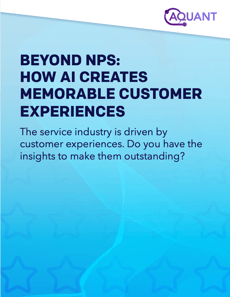
This feature is just one short excerpt from a white paper published by Aquant
www.fieldservicenews.com subscribers can read the full white paper now by hitting the button below.
If you are yet to subscribe you can do so for free by hitting the button and registering for our complimentary subscription tier FSN Standard on a dedicated page that provides you instant access to this white paper PLUS you will also be able to access our monthly selection of premium resources as soo as you are registered.
 Data usage note: By accessing this content you consent to the contact details submitted when you registered as a subscriber to fieldservicenews.com to be shared with the listed sponsor of this premium content Aquant who may contact you for legitimate business reasons to discuss the content of this white paper, as per the terms and conditions of your subscription agreement which you opted into in line with GDPR regulations and is an ongoing condition of subscription.
Data usage note: By accessing this content you consent to the contact details submitted when you registered as a subscriber to fieldservicenews.com to be shared with the listed sponsor of this premium content Aquant who may contact you for legitimate business reasons to discuss the content of this white paper, as per the terms and conditions of your subscription agreement which you opted into in line with GDPR regulations and is an ongoing condition of subscription.
Business leaders are leaning into data-centric decision making as a way to move beyond simply tracking KPIs and determine if their services are actually providing customers with value. With the help of smart tools, you can depend less on instincts and theories, and use methods backed by actual insights to propel your business forward.
How do you know if you need a better way to analyze your business’ big picture? Start by taking a look at the way you currently measure customer value.
"If you currently lack the insight to draw specific conclusions,
it’s time to dig deeper into your data."
If you currently lack the insight to draw specific conclusions, it’s time to dig deeper into your data. To understand the root causes of issues, it’s essential to have the ability to look deeply into metrics — which is where AI becomes a powerful tool to have in your arsenal.
As AI absorbs and analyzes your data, it can provide predictive analytics that help you understand your customers’ behavior. AI provides deep insights and steers the decision-making process, becoming a mighty ally in the quest to maximize customer satisfaction and improve operations.
Ask Yourself:
-
How often does my organization receive customer feedback?
-
If a customer churned tomorrow, would we know why?
-
How do we currently prevent service disasters before they happen?
-
Does our company leverage tech to gain immediate customer feedback on services?
-
Are we using data to analyze the way our customers consume products?
Informed Decisions Lead to More Certain Outcomes
At its finest, AI opens new possibilities, giving you the power to make accurate decisions based on concrete data — not hypotheticals. It goes beyond showing you today’s metrics, guiding you and helping you understand all data relative to your goal. Seasoned business leaders know that while metrics may “unexpectedly” dip or miss the mark, there’s always a reason as to why. Instead of panicking, making assumptions, or instating ineffective countermeasures, it is far more accurate to look at the bigger picture to determine how you arrived at the final outcome.
With AI-powered insights, you become the driver and you control the truthful narrative. It’s time to get ahead of NPS, which offer an incomplete look at your business. If you want to strengthen your customer relationships and get an accurate measure of customer satisfaction, AI can help.
Be proactive instead of reactive. For instance, if your AI tool indicates a few less-than-ideal service moments, you can initiate communication with your customers instead of waiting for feedback to come your way. You can also proactively address customer dissatisfaction before waiting anxiously for the inevitable heated phone call, and you can take the opportunity to tell them what actions you’re taking to rectify the issues. On the other side of the coin, if you notice that your service performance is stellar, you can use that occasion to remind your customers why you’re the choice provider, which may even lead to some awesome upselling opportunities.
Clients and potential customers value transparency more than ever, and AI can bolster your ability to communicate. They will start seeing you as a trusted partner in business — a leader that’s fully vested in their success.
Conclusion
With Aquant’s Service Insights, organizations go beyond visualization and enter the realm of action. Unlike traditional BI tools, our products empower teams to solve their business problems by helping them to quickly analyze disparate data and get clear directions on what to do next.
Actionable feedback shows you what information is most relevant and helps direct you to make the right calls for your business. You can easily identify at-risk customers and address your service issues in real time — without the need for an on-site team of data scientists.
Backed by data from more than five million service tickets from manufacturers and service providers, Service Insights generates trends, industry benchmarks, and predictions that fit the context of your business.
You can also tap into hidden data to make more holistic decisions, and share insights and overviews that identify key statistics and important trends.
The best decisions are made with a 360-degree view, and traditional reporting is no longer enough. The decision to adopt AI is a big one, but it’s a tool that can change the trajectory of your business.

This feature is just one short excerpt from a white paper published by Aquant.
www.fieldservicenews.com subscribers can read the full white paper now by hitting the button below.
If you are yet to subscribe you can do so for free by hitting the button and registering for our complimentary subscription tier FSN Standard on a dedicated page that provides you instant access to this white paper PLUS you will also be able to access our monthly selection of premium resources as soo as you are registered.
 Data usage note: By accessing this content you consent to the contact details submitted when you registered as a subscriber to fieldservicenews.com to be shared with the listed sponsor of this premium content Aquant who may contact you for legitimate business reasons to discuss the content of this white paper, as per the terms and conditions of your subscription agreement which you opted into in line with GDPR regulations and is an ongoing condition of subscription.
Data usage note: By accessing this content you consent to the contact details submitted when you registered as a subscriber to fieldservicenews.com to be shared with the listed sponsor of this premium content Aquant who may contact you for legitimate business reasons to discuss the content of this white paper, as per the terms and conditions of your subscription agreement which you opted into in line with GDPR regulations and is an ongoing condition of subscription.
Further Reading:
- Read more about Aquant on Field Service News @ www.fieldservicenews.com/aquant
- Read more about Digital Transformation @ www.fieldservicenews.com/digital-transformation
- Read more about Leadership & Strategy @ www.fieldservicenews.com//leadership-and-strategy
- Learn more about Aquant @ www.aquant.io
- Follow Aquant on Twitter @ twitter.com/Aquant_io
Jul 22, 2021 • Features • Digital Transformation • Service Leadership • Aquant • customer experience
In this second excerpt from a recent white paper published by Aquant, we discuss which methods are best for creating customer risk scorecards and managing workforce performance issues.
In this second excerpt from a recent white paper published by Aquant, we discuss which methods are best for creating customer risk scorecards and managing workforce performance issues.

This feature is just one short excerpt from a white paper published by Aquant
www.fieldservicenews.com subscribers can read the full white paper now by hitting the button below.
If you are yet to subscribe you can do so for free by hitting the button and registering for our complimentary subscription tier FSN Standard on a dedicated page that provides you instant access to this white paper PLUS you will also be able to access our monthly selection of premium resources as soo as you are registered.
 Data usage note: By accessing this content you consent to the contact details submitted when you registered as a subscriber to fieldservicenews.com to be shared with the listed sponsor of this premium content Aquant who may contact you for legitimate business reasons to discuss the content of this white paper, as per the terms and conditions of your subscription agreement which you opted into in line with GDPR regulations and is an ongoing condition of subscription.
Data usage note: By accessing this content you consent to the contact details submitted when you registered as a subscriber to fieldservicenews.com to be shared with the listed sponsor of this premium content Aquant who may contact you for legitimate business reasons to discuss the content of this white paper, as per the terms and conditions of your subscription agreement which you opted into in line with GDPR regulations and is an ongoing condition of subscription.
A host of analytical and business intelligence (BI) resources exist solely for keeping tabs on metrics.
But standard BI tools still have limitations.
For one, they don’t usually understand a large chunk of your free text service data, including details sourced directly from customer comments, call center agent notes, field technician debriefs, and machine log files. Standard BI tools make it challenging to access, analyze, or interpret unstructured data without a team of data scientists on standby.
Classic BI dashboards only display what’s currently happening within an organization based on past data, which is usually incomplete. The big picture remains obscured once again, making it difficult to use those insights to reach company goals and spot patterns that reveal likely future events. This can lead to the prioritization of unnecessary KPIs, or even worse, analysis paralysis.
Business leaders need total transparency and understanding of their current service landscape to succeed. And these can only be accomplished using tools that give you quick access to easy-to- read analyses that go beyond past trends, offering an idea of what is likely to happen in the future and providing prescriptive recommendations.
Leaders should be leveraging data-centric insights to create the most desired outcomes for their customers — ones that support growth and provide teams with the visibility and know-how to resolve any issues that arise.
Evaluating Performance With Standard KPIs Alone Creates Blind Spots
Most service organizations track KPIs, but too many narrowly focus on single measurements such as first time fix. Knowing the FTF rate is an important performance indicator, but when measured in a vacuum, it offers an incomplete or inaccurate snapshot of the health of your service organization.
Without zooming out for a 360-degree view, decisions that boost one KPI might lead to systemic and costly service issues. For example, how is team performance impacting customer satisfaction, or how are high first time fix rates driving up service costs?
It is beneficial to have a comprehensive understanding of service KPIs, including:
-
First time fix (FTF)
-
Mean time to resolution (MTTR)
-
Mean time between failure (MTBF)
By looking at these metrics in depth, you’ll gain deeper insight into every aspect of the service lifecycle, and see clear connections between performance and service outcomes.

This feature is just one short excerpt from a white paper published by Aquant.
www.fieldservicenews.com subscribers can read the full white paper now by hitting the button below.
If you are yet to subscribe you can do so for free by hitting the button and registering for our complimentary subscription tier FSN Standard on a dedicated page that provides you instant access to this white paper PLUS you will also be able to access our monthly selection of premium resources as soo as you are registered.
 Data usage note: By accessing this content you consent to the contact details submitted when you registered as a subscriber to fieldservicenews.com to be shared with the listed sponsor of this premium content Aquant who may contact you for legitimate business reasons to discuss the content of this white paper, as per the terms and conditions of your subscription agreement which you opted into in line with GDPR regulations and is an ongoing condition of subscription.
Data usage note: By accessing this content you consent to the contact details submitted when you registered as a subscriber to fieldservicenews.com to be shared with the listed sponsor of this premium content Aquant who may contact you for legitimate business reasons to discuss the content of this white paper, as per the terms and conditions of your subscription agreement which you opted into in line with GDPR regulations and is an ongoing condition of subscription.
Further Reading:
- Read more about Aquant on Field Service News @ www.fieldservicenews.com/aquant
- Read more about Digital Transformation @ www.fieldservicenews.com/digital-transformation
- Read more about Leadership & Strategy @ www.fieldservicenews.com//leadership-and-strategy
- Learn more about Aquant @ www.aquant.io
- Follow Aquant on Twitter @ twitter.com/Aquant_io
Jul 15, 2021 • Features • Digital Transformation • Aquant • Covid-19 • customer experience
In the first article of a series of excerpts from a recent white paper published by Aquant, we look at the importance of providing exceptional customer experience in the post-pandemic world.
In the first article of a series of excerpts from a recent white paper published by Aquant, we look at the importance of providing exceptional customer experience in the post-pandemic world.

This feature is just one short excerpt from a white paper published by Aquant
www.fieldservicenews.com subscribers can read the full white paper now by hitting the button below.
If you are yet to subscribe you can do so for free by hitting the button and registering for our complimentary subscription tier FSN Standard on a dedicated page that provides you instant access to this white paper PLUS you will also be able to access our monthly selection of premium resources as soo as you are registered.
 Data usage note: By accessing this content you consent to the contact details submitted when you registered as a subscriber to fieldservicenews.com to be shared with the listed sponsor of this premium content Aquant who may contact you for legitimate business reasons to discuss the content of this white paper, as per the terms and conditions of your subscription agreement which you opted into in line with GDPR regulations and is an ongoing condition of subscription.
Data usage note: By accessing this content you consent to the contact details submitted when you registered as a subscriber to fieldservicenews.com to be shared with the listed sponsor of this premium content Aquant who may contact you for legitimate business reasons to discuss the content of this white paper, as per the terms and conditions of your subscription agreement which you opted into in line with GDPR regulations and is an ongoing condition of subscription.
The acceleration of digital technologies in every sector from grocery delivery to banking created customer expectations that are higher than ever. And there’s every indication that it will remain this way.
Customers want effortless service interactions. To win hearts and wallets, you have to provide interactions that go beyond “good.” Every interaction should feel personalized while also aiming to wow. For service organizations, the expectation is that you’ve joined all the dots before a service ticket is placed.
For many organizations who are already in the midst of transformation projects, the question is how to pivot technology adoption and service delivery to achieve those goals. For some, Net Promoter Score (NPS) has been the best way to do that. They monitor loyalty and metrics and give companies intel on how users feel about services — but in the current landscape, where time is money, there are a few drawbacks. Often, the feedback is too ambiguous, arrives too late, and lacks full context, rendering companies powerless to change outcomes.
NPS can’t tell you why a customer left a particular rating, doesn’t explain why clients are loyal, and doesn’t provide guidance on how to improve your services. When measured alone, NPS leaves a lot of room for interpretation and little for prevention.
Additionally, NPS won’t help service leaders innovate, nor can it help teams achieve opposing business goals. There is a need to improve customer experiences, but it’s likely you’ve also been tasked with hitting other goals including cost savings and service efficiencies.
A better way to deliver exceptional experiences, manage relationships, and work towards larger company goals is to use preexisting service data as a guide. Innovative organizations are looking at artificial intelligence’s (AI) capabilities to surface critical data and bring insights and knowledge to the forefront. Organizations are realizing that it can take twice as much effort to repair a broken customer relationship than maintain a healthy one. To start predicting customer issues before client relationships sour, use data to contextualize your current offerings and relationships.
Strenghten Relationship by Defining Them
Modern technology is convenient: clients can research and decide to go with another manufacturer or provider at any given point. Therefore, you need to do everything in your power to earn and keep your customers’ loyalty. A good way to start is by making sure that you are differentiating your products and services.
Yet isolated answers can’t provide the big picture, even with the help of KPI data. It can still be a challenge to see the underlying health of your organization or customer relationships.
Seemingly-healthy dashboards may be one issue away from bubbling over, making it more crucial than ever to adopt the right tools to unearth and manage your metrics.
Consider the Following:-
If you were the customer, why would you choose your company’s product or service?
-
Do your goals align with your clients’?
-
How are you ensuring that you’re meeting customer expectations?
-
Are you measuring your clients’ loyalty beyond NPS?
-
Are you at risk of losing any customers?
-
If your largest client decided to choose another product or service, how would this impact your business?

This feature is just one short excerpt from a white paper published by Aquant.
www.fieldservicenews.com subscribers can read the full white paper now by hitting the button below.
If you are yet to subscribe you can do so for free by hitting the button and registering for our complimentary subscription tier FSN Standard on a dedicated page that provides you instant access to this white paper PLUS you will also be able to access our monthly selection of premium resources as soo as you are registered.
 Data usage note: By accessing this content you consent to the contact details submitted when you registered as a subscriber to fieldservicenews.com to be shared with the listed sponsor of this premium content Aquant who may contact you for legitimate business reasons to discuss the content of this white paper, as per the terms and conditions of your subscription agreement which you opted into in line with GDPR regulations and is an ongoing condition of subscription.
Data usage note: By accessing this content you consent to the contact details submitted when you registered as a subscriber to fieldservicenews.com to be shared with the listed sponsor of this premium content Aquant who may contact you for legitimate business reasons to discuss the content of this white paper, as per the terms and conditions of your subscription agreement which you opted into in line with GDPR regulations and is an ongoing condition of subscription.
Further Reading:
- Read more about Aquant on Field Service News @ www.fieldservicenews.com/aquant
- Read more about Digital Transformation @ www.fieldservicenews.com/digital-transformation
- Read more about Leadership & Strategy @ www.fieldservicenews.com//leadership-and-strategy
- Learn more about Aquant @ www.aquant.io
- Follow Aquant on Twitter @ twitter.com/Aquant_io
Jun 30, 2021 • News • field service management • IFS • Leadership and Strategy • GLOBAL • customer experience
Businesses are missing out on a significant opportunity to use technology to fix internal processes and address the root causes of customer experience issues in the wake of the pandemic, research from enterprise software specialist IFS has today...
Businesses are missing out on a significant opportunity to use technology to fix internal processes and address the root causes of customer experience issues in the wake of the pandemic, research from enterprise software specialist IFS has today revealed.
The global study, which surveyed 1,700+ executives and 12,000+ consumers, shows that businesses understand software has a key role to play in consistently delivering positive outcomes, but that current approaches to customer experience do little more than wallpaper over the cracks, instead of identifying and addressing systemic problems in their operations.
Although businesses claim to pay close attention to customer service, the inflection points that occur throughout the lifecycle of their operations and encompass processes, technology solutions, and human coordination are even more important to a positive customer experience – but these are far too frequently overlooked. It is only with careful orchestration of these components that companies can deliver a quality ‘Moment of Service’, in which everything comes together to create a positive result for a customer.
29% of managers don’t take action on known operational issues, while 18% are too busy to report issues not considered urgent
This orchestration is only possible when the technological foundations are in place to provide visibility of these inflection points. Only then can businesses take the appropriate action to ensure they delight, and don’t disappoint, their customers. Indeed, some 85 percent of businesses said that their enterprise software helped them measure performance and act on issues at these inflection points to affect the end customer outcome.
However, IFS’s research also uncovered that while 79 percent of businesses have invested time and resources in identifying where these inflection points are, when problems are identified nearly a third of managers (29 percent) admitted to reporting them but not taking any action. Furthermore, some 18 percent revealed they were too busy to report issues unless urgent, while just 15 percent said they proactively look to preempt problems.
Despite the majority of companies (66 percent) investing upwards of $250,000 each year evaluating the customer experience through Net Promoter Scores, reviews, and customer satisfaction surveys, it is clear that unless they resolve these issues when they find them, customers are unlikely to see a meaningful change in their experience. Indeed, 82 percent of respondents were unable to recall a single positive example of a recent frictionless customer experience. This gap between understanding and acting is a business risk that few can afford.
For enterprises that fail at the moment of service, the ramifications are significant. A quarter of consumer respondents stated they would never engage with a brand again after just one bad experience, while over half (52 percent) would abandon a company after two to three. IFS also sought to examine the impact of negative experiences on wider brand perception and uncovered that 58 percent of consumers are very likely or somewhat likely to share their negative perceptions with their network, highlighting how easily a bad interaction can be amplified.
90% of businesses now reengineering operations to ensure better customer experiences
However, it’s not all doom and gloom. Over half (52 percent) of consumers are inclined to leave a positive review, underscoring just how much can be gained by focusing on delivering an exceptional customer experience.
To ensure they’re delivering the optimal customer experiences that breed this kind of advocacy, businesses need to rearchitect themselves to remove pain points and streamline operations, rather than trying to talk their way out of issues they walked themselves into. Investing in the right enterprise technology, that enables them to not only address current problems, but adapt to emerging conditions will be key to consistently delivering positive outcomes for customers and a powerful competitive differentiator for organizations.
“When it comes to delivering a positive customer experience, businesses have a limited opportunity to get it right. And if they neglect to assure every single inflection point, they are gambling with their outcomes,” IFS Chief Customer Officer Michael Ouissi said. “There are many points where you can either delight or disappoint a customer across the value chain and it is clear from these findings that consumers are willing to voice their opinions either way. As more and more businesses look to service provision as a key competitive differentiator, running the right enterprise software—engineered for the moment of service and which is able to orchestrate the multitude of people, assets and customers—will separate the winners from the losers.”
With 90 percent of businesses stating they have reengineered or are reengineering their business to ensure customer touchpoints and stages come together for better moments of service, it is vital that companies ensure processes are optimized across each of these inflection points to mitigate issues and fuel growth.
IFS believes a composable enterprise approach, which harnesses a combination of packaged functions and technologies to derive data-driven insight and deliver positive outcomes, will be key to delighting customers and creating competitive advantage, but businesses need to move quickly to seize this opportunity.
Download a copy of the report Fixing the fundamentals: Understanding new business models and opportunities in the wake of Covid-19.
Further Reading:
- Read more about Leadership and Strategy @ www.fieldservicenews.com/leadership-and-strategy
- Read more about IFS on Field Service News @ https://www.fieldservicenews.com/ifs
- Find out more about IFS @ www.ifs.com/
- Download a copy of the IFS Study @ www.ifs.com/sitecore/media-library/assets/fixing-the-fundamentals/
- Follow IFS on Twitter @ twitter.com/ifs






















 Field Service News is published by 1927 Media Ltd, an independent publisher whose sole focus is on the field service sector. As such our entire resources are focused on helping drive the field service sector forwards and aiming to best serve our industry through honest, incisive and innovative media coverage of the global field service sector.
Field Service News is published by 1927 Media Ltd, an independent publisher whose sole focus is on the field service sector. As such our entire resources are focused on helping drive the field service sector forwards and aiming to best serve our industry through honest, incisive and innovative media coverage of the global field service sector.
Leave a Reply